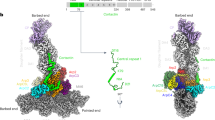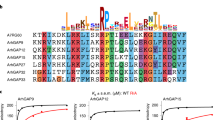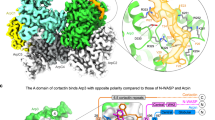Abstract
Cortactin, a filamentous actin (F-actin)-associated protein and prominent substrate of Src, is implicated in progression of breast tumours through gene amplification at chromosome 11q13. However, the function of cortactin remains obscure. Here we show that cortactin co-localizes with the Arp2/3 complex, a de novo actin nucleator, at dynamic particulate structures enriched with actin filaments. Cortactin binds directly to the Arp2/3 complex and activates it to promote nucleation of actin filaments. The interaction of cortactin with the Arp2/3 complex occurs at an amino-terminal domain that is rich in acidic amino acids. Mutations in a conserved amino-acid sequence of DDW abolish both the interaction with the Arp2/3 complex and complex activation. The N-terminal domain is not only essential but also sufficient to target cortactin to actin-enriched patches within cells. Interestingly, the ability of cortactin to activate the Arp2/3 complex depends on an activity for F-actin binding, which is almost 20-fold higher than that of the Arp2/3 complex. Our data indicate a new mechanism for activation of actin polymerization involving an enhanced interaction between the Arp2/3 complex and actin filaments.
This is a preview of subscription content, access via your institution
Access options
Subscribe to this journal
Receive 12 print issues and online access
$209.00 per year
only $17.42 per issue
Buy this article
- Purchase on Springer Link
- Instant access to full article PDF
Prices may be subject to local taxes which are calculated during checkout






Similar content being viewed by others
References
Schuuring, E. D., Verhoeven, E., Litvinov, S. & Michalides, R. J. A. M. The product of the EMS1 gene, amplified and overexpressed in human carcinomas, is homologous to a v-src substrate and is located in cell-substratum contact sites. Mol. Cell Biol. 13, 2891–2898 (1993).
Wu, H., Reynolds, A. B., Kanner, S. B., Vines, R. R. & Parsons, J. T. Identification and characterization of a novel cytoskeleton-associated pp60src substrate. Mol. Cell Biol. 11, 5113–5124 (1991).
Zhan, X. et al. Murine cortactin is phosphorylated in response to fibroblast growth factor-1 on tyrosine residues late in the G1 phase of the BALB/c 3T3 cell cycle. J. Biol. Chem. 268, 24427–24431 (1993).
Schuuring, E. The involvement of the chromosome 11q13 region in human malignancies: cyclin D1 and EMS1 are two new candidate oncogenes. Gene 159, 83–96 (1995).
Maruyama, S. et al. Physical and functional association of cortactin with Syk in human leukemic cell line K562. J. Biol. Chem. 271, 6631–6635 (1996).
Kim, L. & Wong, T. W. Growth factor-dependent phosphorylation of the actin-binding protein cortactin is mediated by the cytoplasmic tyrosine kinase FER. J. Biol. Chem. 273, 23542–23548 (1998).
Gallet, C. et al. Tyrosine phosphorylation of cortactin associated with Syk accompanies thromboxane analogue-induced platelet shape change. J. Biol Chem 274, 23610–23616 (1999).
Liu, M., Qin, Y., Tanswell, A. K. & Post, M. Mechanical stress induces pp60src activation and translocation to cytoskeleton in fetal rat lung cells. J. Biol. Chem. 271, 7066–7071 (1996).
Kapus, A., Szaszi, K., Sun, J., Rizoli, S. & Rotstein, O. D. Cell shrinkage regulates Src kinases and induces tyrosine phosphorylation of cortactin, independent of the osmotic regulation of Na+/H+ exchangers. J. Biol. Chem. 274, 8093–8102 (1999).
Li, Y., Liu, J. & Zhan, X. The role of cortactin and Src in the H2O2-mediated injury of human endothelial cells. J. Biol. Chem. 275, 37187–37193 (2000).
Huang, C. et al. Down regulation of the F-actin crosslinking activity of cortactin by c-Src. J. Biol. Chem. 272, 13911–13915 (1997).
Huang, C., Liu, J., Haudenschild, C. C. & Zhan, X. The role of tyrosine phosphorylation of cortactin in the locomotion of endothelial cells. J. Biol. Chem. 273, 25770–25776 (1998).
Kitamura, D., Kaneko, H., Miyagoe, Y., Ariyasu, T. & Watanabe, T. Isolation and characterization of a novel human gene expressed specifically in the cells of hematopoietic lineage. Nucleic Acids Res. 17, 9367–9379 (1989).
Bowden, E. T., Barth, M., Thomas, D., Glazer, R. I. & Mueller, S. C. An invasion-related complex of cortactin, paxillin and PKCmu associates with invadopodia at sites of extracellular matrix degradation. Oncogene 18, 4440–4449 (1999).
Dehio, C., Prevost, M. C. & Sansonetti, P. J. Invasion of epithelial cells by Shigella flexneri induces tyrosine phosphorylation of cortactin by a pp60c-src-mediated signalling pathway. EMBO J. 14, 2471–2482 (1995).
Fawaz, F. S., van Ooij, C., Homola, E., Mutka, S. C. & Engel, J. N. Infection with Chlamydia trachomatis alters the tyrosine phosphorylation and/or localization of several host cell proteins including cortactin. Infect. Immun. 65, 5301–5308 (1997).
Cantarelli, V. V., Takahashi, A., Akeda, Y., Nagayama, K. & Honda, T. Interaction of enteropathogenic or enterohemorrhagic Escherichia coli with HeLa cells results in translocation of cortactin to the bacterial adherence site. Infect. Immun. 68, 382–386 (2000).
Pollard, T. D., Blanchoin, L. & Mullins, R. D. Molecular mechanisms controlling actin filament dynamics in nonmuscle cells. Annu. Rev. Biophys. Biomol. Struct. 29, 545–576 (2000).
Welch, M. D., Iwamatsu, A. & Mitchison, T. J. Actin polymerization is induced by Arp2/3 protein complex at the surface of Listeria monocytogenes. Nature 385, 265–269 (1997).
Svitkina, T. M. & Borisy, G. G. Arp2/3 complex and actin depolymerizing factor/cofilin in dendritic organization and treadmilling of actin filament array in lamellipodia. J. Cell Biol. 145, 1009–1026 (1999).
Blanchoin, L. et al. Direct observation of dendritic actin filament networks nucleated by Arp2/3 complex and WASP/Scar proteins. Nature 404, 1007–1011 (2000).
Mullins, R. D., Heuser, J. A. & Pollard, T. D. The interaction of Arp2/3 complex with actin: nucleation, high affinity pointed end capping, and formation of branching networks of filaments. Proc. Natl Acad. Sci. USA 95, 6181–6186 (1998).
Machesky, L. M. et al. Scar, a WASp-related protein, activates nucleation of actin filaments by the Arp2/3 complex. Proc. Natl Acad. Sci. USA 96, 3739–3744 (1999).
Winter, D., Lechler, T. & Li, R. Activation of the yeast Arp2/3 complex by Bee1p, a WASP-family protein. Curr. Biol. 9, 501–504 (1999).
Egile, C. et al. Activation of the CDC42 effector N-WASP by the Shigella flexneri IcsA protein promotes actin nucleation by Arp2/3 complex and bacterial actin-based motility. J. Cell Biol 146, 1319–1332 (1999).
Yarar, D., To, W., Abo, A. & Welch, M. D. The Wiskott–Aldrich syndrome protein directs actin-based motility by stimulating actin nucleation with the Arp2/3 complex. Curr. Biol. 9, 555–558 (1999).
Skoble, J., Portnoy, D. A. & Welch, M. D. Three regions within ActA promote Arp2/3 complex-mediated actin nucleation and Listeria monocytogenes motility. J. Cell Biol. 150, 527–538 (2000).
Machesky, L. M. & Insall, R. H. Scar1 and the related Wiskott–Aldrich syndrome protein, WASP, regulate the actin cytoskeleton through the Arp2/3 complex. Curr. Biol. 8, 1347–1356 (1998).
Uversky, V. N. & Ptitsyn, O. B. `Partly folded' state, a new equilibrium state of protein molecules: four-state guanidinium chloride-induced unfolding of beta-lactamase at low temperature. Biochemistry 33, 2782–2791 (1994).
Rohatgi, R. et al. The interaction between N-WASP and the Arp2/3 complex links Cdc42-dependent signals to actin assembly. Cell 97, 221–231 (1999).
Mullins, R. D. & Pollard, T. D. Structure and function of the Arp2/3 complex. Curr. Opin. Struct. Biol. 9, 244–249 (1999).
Carson, M., Weber, A. & Zigmond, S. H. An actin-nucleating activity in polymorphonuclear leukocytes is modulated by chemotactic peptides. J. Cell Biol. 103, 2707–2714 (1986).
Wu, H. & Parsons, J. T. Cortactin, an 80/85-kilodalton pp60(src) substrate, is a filamentous actin-binding protein enriched in the cell cortex. J. Cell Biol. 120, 1417–1426 (1993).
Miki, H. & Takenawa, T. Direct binding of the verprolin-homology domain in N-WASP to actin is essential for cytoskeletal reorganization. Biochem. Biophys. Res. Commun. 243, 73–78 (1998).
Higgs, H. N., Blanchoin, L. & Pollard, T. D. Influence of the C terminus of Wiskott–Aldrich syndrome protein (WASp) and the Arp2/3 complex on actin polymerization. Biochemistry 38, 15212–15222 (1999).
Mullins, R. D., Stafford, W. F. & Pollard, T. D. Structure, subunit topology, and actin-binding activity of the Arp2/3 complex from Acanthamoeba. J. Cell Biol. 136, 331–343 (1997).
Pantaloni, D., Boujemaa, R., Didry, D., Gounon, P. & Carlier, M-F. The Arp2/3 complex branches filament barbed ends: functional antagonism with capping proteins. Nature Cell Biol 2, 385–391 (2000).
Weed, S. A. et al. Cortactin localization to sites of actin assembly in lamellipodia requires interactions with F-actin and the Arp2/3 complex. J. Cell Biol. 151, 29–40 (2000).
Hiura, K., Lim, S. S., Little, S. P., Lin, S. & Sato, M. Differentiation dependent expression of tensin and cortactin in chicken osteoclasts. Cell Motil. Cytoskeleton 30, 272–284 (1995).
Blair, H. C., Teitelbaum, S. L., Ghiselli, R. & Gluck, S. Osteoclastic bone resorption by a polarized vacuolar proton pump. Science 245, 855–857 (1989).
Huang, C. & Zhan, X. Proteolysis of cortactin by calpain in platelets and in vitro. Methods Mol. Biol. 144, 289–295 (2000).
Acknowledgements
This work was supported by grants from the National Institutes of Health, the American Heart Association and the Department of Army.
Author information
Authors and Affiliations
Corresponding author
Rights and permissions
About this article
Cite this article
Uruno, T., Liu, J., Zhang, P. et al. Activation of Arp2/3 complex-mediated actin polymerization by cortactin. Nat Cell Biol 3, 259–266 (2001). https://doi.org/10.1038/35060051
Received:
Revised:
Accepted:
Published:
Issue Date:
DOI: https://doi.org/10.1038/35060051



